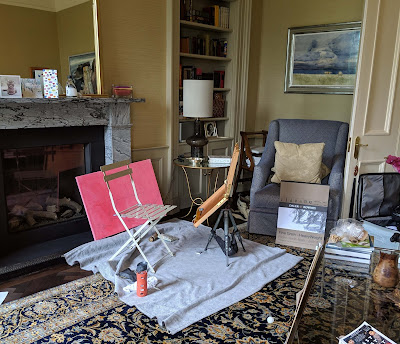I’m studying Francis Cadell before a portrait commission takes me to his home town.
 |
|
Portrait of a Lady in Black, c. 1921, Francis Cadell, courtesy National Gallery of Scotland.
|
Sutherland was not primarily a portrait artist, but a tapestry designer and landscape painter. He thoroughly embraced modernism. There are some artists who could combine that with warmth, but for most of the 20thcentury, modernism was coupled with cool disdain. Sutherland’s portraits, mainly done in the 1950s, are icily insightful. Many illustrious people sat for him, so he was a logical choice for the parliamentarians who commissioned the painting. Sutherland was fashionable.
 |
|
Interior, The Orange Blind, c. 1914, by Francis Cadell, courtesy Kelvingrove Art Gallery and Museum. Unless Cadell was on a ladder, this is an imagined viewpoint.
|
Another painter who did portraits as part of a larger
ouevre was the
Scottish Colourist Francis Cadell. He was skilled at still life, interiors, and
plein air landscapes. He was also a portrait painter in his native Edinburgh. Unlike Sutherland’s, his portraits are sympathetic. They tie their subjects to what interested him most—the house and furnishings that provided the setting.
Lesser thinkers might have made a cynical statement about materialism, and in more sophisticated cities, that would have been lapped up. However, there’s absolutely no condescension in Cadell’s worldview. He is as interested in interiors as they are. As an artist, he comes across as a thoroughly nice man.
 |
|
The Parting, c. 1915, Francis Cadell, courtesy National Gallery of Scotland.
|
Cadell was the only Colourist to serve in the Great War. Before he was sent to the Front, he did a series of drawings in ink and watercolor. These are fast, witty drawings built on graphic design and splashes of color.
His later paintings worked off the same idea. He created meticulous, exciting value compositions in white, cream and black, and shot them through with highlights of bold color. That color was often red.
I’m studying Cadell because I’m going to Scotland next Spring. I’ll do a portrait, in a home on the next street to where Cadell lived and worked for nearly 12 years. He painted his Portrait of a Lady in Black, above, in his Ainslie Place studio. As with so many of his paintings, it’s as much a portrait of a place as of a woman. In fact, the model, Bertia Don Wauchope, was not a client at all, but his regular model.
We read the shape between the fan and her torso first, because it’s the highest contrast in the painting. Rapidly, though, we begin to see the spaces defined in mauve, and the reflection of her great hat in the mirror. It’s a stunning monochromatic composition alleviated only by the pink of that ridiculous flower and a slash of lipstick. And yet there’s nothing dehumanized about it.
 |
|
The Vase of Water, 1922, Francis Cadell. His studio had mauve walls, so it’s an indication that the painting was done there.
|
The key to Cadell’s portraits are, in fact, his still lives. He ruthlessly reduced detail and shadow into blocks of brilliant color. Their main purpose was to provide a brilliantly faceted abstract framework. And yet there is a casualness to them that make them plausible moments stolen from life.
Sticking an international trip into my summer schedule is impossible, so I plan to go in May, as soon as the weather warms enough to paint outdoors. A side trip to
Ionaseems inevitable. After all, that’s where I first met Cadell and the other Colourists. This time, I’m bringing my oils.




















